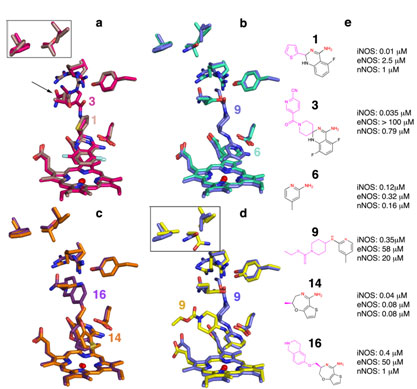This un ipped ribose is in stark contrast to the structures of all other HhH glycosylases bound to abasic DNA. A crystallographic model with the Table I Information collection, phasing, and refinement statistics  Native Se peak Unliganded TAG no cost protein, which consists of two TAG molecules from the asymmetric unit, was constructed into one. 5 A MAD electron density and refined to a crystallographic residual of 0. 161 . Likewise, the model on the TAG/THF DNA/mA solution complicated was constructed into 1. 85 A Sad experimental electron density and refined to a crystallographic residual of 0. 175 . The crystal structures of S. typhi TAG are consistent with NMR structures with the E. coli enzyme that recognized TAG as a member of the HhH superfamily of DNA glycosylases .
Native Se peak Unliganded TAG no cost protein, which consists of two TAG molecules from the asymmetric unit, was constructed into one. 5 A MAD electron density and refined to a crystallographic residual of 0. 161 . Likewise, the model on the TAG/THF DNA/mA solution complicated was constructed into 1. 85 A Sad experimental electron density and refined to a crystallographic residual of 0. 175 . The crystal structures of S. typhi TAG are consistent with NMR structures with the E. coli enzyme that recognized TAG as a member of the HhH superfamily of DNA glycosylases .
TAG adopts a globular fold consisting of an a helical domain that contains SNDX-275 the HhH motif in addition to a second, unique Zn binding domain that tethers the N and C termini . The mA binding pocket is located at the interface concerning the two domains . Superposition of your S. typhi and E. coli structures shows that the protein backbones and positions of bound mA are nearly identical . Remarkably, the largest differences among the two structures occur from the positions of two conserved tryptophan side chains during the mA binding pocket. Every single in the indole rings of Trp 6 and Trp 21 are rotated B1201 among the two designs . According to the substantial degree of sequence and structural conservation in between S. typhi and E. coli TAG, these differences are probable an artifact of structure determina tion and not inherent variations between the two orthologs.
DNA binding by TAG The HhH glycosylases use a popular mechanism for binding DNA. These proteins anchor the two strands from the DNA duplex from your minor groove side by van der Waals and polar interactions with all the bases along with the phosphate backbone. Principal Nilotinib chain atoms from the HhH hairpin type hydrogen 2 t bonds with two phosphate groups immediately 0 to the lesion, whereas positively charged side chains from a con served protein loop engage the non lesioned strand. An intercalating side chain occupies the gap in the DNA left through the ipped out nucleotide, and a second side chain wedges to the non lesioned DNA opposite the ipped out nucleotide. Collectively, these interactions stabi lize a 60 701 bend while in the duplex and support the protein get entry to the modified base.
TAG binds DNA similarly to other HhH glycosylases , with subtle one of a kind variations Protease that categorize TAG being a divergent member of your superfamily and that very likely end result in its substantial specificity for positively charged mA bases. The DNA is anchored towards the protein by three hairpin loops formed from helices B/C, E/F, as well as the HhH motif . Essential side chain and key chain atoms from your HhH motif bind the phosphate groups 0 to the abasic website, whereas basic residues from your E/F loop get in touch with the DNA backbone about the non lesioned strand . The loop in between helices B and C inserts into the abasic gap inside the DNA duplex, and the details will probably be discussed below. The DNA is kinked on the THF web site by B621, using the two duplex arms on either side from the bend mostly B type DNA.
Interestingly, you will find no protein DNA con tacts with all the five base pairs upstream on the lesion , and also the B elements for that DNA are drastically increased at that finish. The structures of TAG within the absolutely free state and when bound to solution DNA are in essence identical, with r. m. s. deviations of 0. six A and one. 0 A . As a result, no PI-103 sig nificant protein motion is needed to engage the DNA. TAG is made up of a unique HhH motif that accounts for about half of your polar interactions with all the DNA backbone. Amide nitrogens from Phe156, Gly158, Thr160, and Ile161 type hydrogen bonds for the phosphate groups 0 for the THF site O 0 P bond, whilst the complete backbone of nucleotides C5, T6, and THF7 considerably deviates from that of B DNA .
As well as torsional rotation, the two DNA conformations differ by a 2 A translation all over thymine T6, a motion that affects the positions of each the backbone and thymine base. The slight positional disorder in thymine T6 is re ected in the discontinuous electron density and high B aspects of this FDA residue. The a number of conformations in the phosphate backbone are probable a consequence from the sharp kink from the DNA and also the lack of specific protein DNA contacts with the abasic web page and inside the duplex five 0 for the lesion. Remarkably, both ipped and stacked orientations on the ribose ring make only nonspecific van der Waals contacts with TAG.
